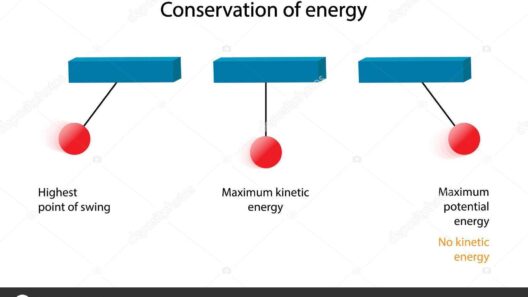Newton’s Cradle serves as a fascinating metaphor for the principles of energy conservation and momentum. This elegant device, often found on desks and tables, consists of a series of swinging spheres that demonstrate the principle of conservation of momentum and kinetic energy. But does energy truly remain conserved within this seemingly simple construct? The answer is more profound than one might initially presume.
At the heart of the inquiry lies the definition of energy conservation itself. In a closed system, where no external forces intervene, the total energy remains constant. In the case of Newton’s Cradle, the system comprises the heavy balls and the gravitational field in which they function. When one ball is raised and released, it collides with the stationary row of spheres and transmits its energy through them, resulting in the last ball in the series swinging outward in an apparent display of energy transfer. The initial energy imparted to the first ball seems to remain conserved as it is transferred to the last.
However, to understand the nuances of this system, it is imperative to consider both momentum and energy. Before the balls collide, the first ball possesses kinetic energy due to its motion and potential energy related to its height when raised. Upon collision, this energy doesn’t merely vanish; it is redistributed across the entire system. This showcases a fundamental principle: energy can transition between forms but not be created or annihilated.
What occurs during the collision is a complex interplay of forces and masses. As each ball strikes the next, it pushes the subsequent one. The kinetic energy carried by the incoming ball is redistributed, resulting in the last ball swinging away while the others are momentarily stationary. The exchange is not instantaneous; instead, it involves both elastic and inelastic components. The “click-clack” sound is not merely an auditory cue; it’s a manifestation of energy losses accompanied by sound and slight vibrations.
Yet, even in this dynamic show of conservation, practicalities introduce a degree of inefficiency. In a real-world setting, no system is perfectly isolated. Over time, energy dissipates in various forms such as thermal energy arising from friction between the balls and the supports that hold them. Inevitably, the balls lose energy in the form of heat, meaning that while momentum may appear conserved at first glance, kinetic energy gradually depletes with each cycle.
Here lies the allure of Newton’s Cradle. It invites observers to ponder not only the immediate effects of energy transfer but also the broader implications of conservation in our world. This concept extends well beyond the confines of a desktop toy. The debate surrounding energy conservation underlies significant environmental discussions, encouraging a reevaluation of how energy is utilized and conserved in everyday life.
The principles demonstrated by Newton’s Cradle can serve as an analogy for larger systems, from ecological networks to societal structures. As our planet grapples with the pressing challenges of energy consumption and environmental sustainability, understanding the delicate balances depicted in this simple apparatus can inspire innovative solutions. How can we harness this fundamental truth of energy conservation to rethink our strategies for resource management? What can we learn from the rhythmic elegance of the cradle about achieving harmony in our energy systems?
Moreover, as we delve into broader energy systems, such as those utilized in renewable technologies, the conversation transforms into one of efficiency and sustainability. For instance, in solar panels and wind turbines, energy transformation is critical. Just like the balls in a cradle, energy must be efficiently transferred from one form to another. The efficiency of these systems directly influences their viability in a world increasingly dependent on dwindling fossil fuels.
Also noteworthy is the behavioral aspect of energy consumption. The analogy of Newton’s Cradle extends to societal implications in regard to our collective energy choices. The click-clack of the balls resonates with decisions impacting energy consumption. Each choice resonates through the wider community, reminiscent of the cascading effect seen in a series of colliding balls. As individuals, our actions can either contribute to a resonance of conservation or lead to energy dispersal, resulting in loss rather than preservation.
In conclusion, while Newton’s Cradle may pragmatically illustrate kinetic energy transfer and conservation of momentum, its underlying lessons beckon us to rethink our approaches to energy use and conservation on a grander scale. Energy conservation is not merely a scientific principle; it is an imperative that calls for conscientious engagement from individuals, societies, and nations. As we observe the rhythmic interplay of the balls, we are reminded of our role in the global energy system. The click-clack of each collision should serve as a call to vigilance—energizing a commitment toward sustainability and conservation for generations to come.
In this context, understanding energy conservation in Newton’s Cradle becomes more than an academic exercise; it emerges as a palpable framework for developing awareness around one of humanity’s most pressing challenges: ensuring that energy conservation transcends the simple mechanics of a playful apparatus and transforms into a way of life.








